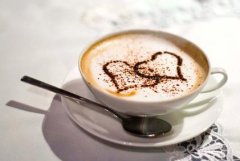French Coffee Culture History Coffee Culture Common sense
I have heard that France once drank less coffee because of a shortage of coffee, and immediately saw more people taking a nap. It may seem like an exaggeration, but it is true that the French are addicted to coffee. When the "Gulf War" broke out in 1991, France was also one of the countries participating in the war. some domestic people worried that the war would affect the supply of daily necessities, so they rushed to supermarkets to buy them. Even the TV station was alarmed by the fact that when the camera looked at customers full of "scarce goods", they found that what they got the most was coffee and sugar. At one point, it became a big joke at that time.

The French do not seem to pay attention to the taste, but the environment and atmosphere. Most of them do not want to drink alone behind closed doors, but join in the fun outside, even if the price of a small cup is enough to make a pot at home. They did not drink hurriedly, but tasted it slowly, tasted it carefully, read books and newspapers, talked about it, and "soaked" for most of the day. When I walked through six or seven large exhibition halls at the Science and Technology Expo, I saw that there were cafes on the corner to facilitate exchanges and negotiations among people from all walks of life.
French people develop this habit of drinking coffee, whether they consciously express a kind of elegant charm, a kind of romantic sentiment, a kind of comfortable feeling of enjoying life. It can be said that this is a traditional and unique coffee culture. Because of this, the places where people can rest and drink coffee in France can be said to be all over the streets, under the shade of trees, by the road, by the square, on the river bank, on cruise ships, on street balconies, and even on the Eiffel Tower. There are coffee shops, cafes, halls, rooms, all of which are attached to buildings and covered by roofs, regardless of form, style, size or size. And the most popular and romantic ones are those open-air cafes, which are almost a portrayal of French life.
Many open-air cafes occupy many public places, such as a corner of the square, sidewalks on the streets, even on the bustling boulevard of Xiangxie, where colorful umbrellas have become a unique streetscape that embellishes Paris. it seems that the municipal authorities are particularly tolerant of this. The chairs of the cafe are almost all facing the road, which is obviously an intentional auditorium, and the road in front of it is the big stage where the repertoire will never be repeated. Look at all kinds of guests, despite the hustle and bustle of the street, heavy traffic, a cup under the umbrella, leisurely and leisurely. You can take a local newspaper and read it aimlessly, smoke with cigarettes, and enjoy the colorful streets. Here, there will be bright fashion flash, there will be intoxicating fragrance, there will be Jionna colorful girls passing by, and often street musicians will bring you beautiful melodies. The situation is intoxicating. It is not difficult to see the original whispering lovers hugging and kissing, but others can not envy so much, because this is in France. If you are lucky, there may be a French beauty sitting on the chair beside you, which will add a lot of visual enjoyment to you. Here, a Parisian girl sipping coffee while reading a fashion magazine is seen as a symbol of fashion.
In addition to those open-air cafes that look up to the blue sky, there is no shortage of magnificent or simple and elegant people in about 170000 of the cafes in France. Especially in Paris, some cafes are themselves legendary places of interest. In the old dynasty of the Middle Ages, the focus of French cultural life was in the palace. In the age of enlightenment in the 18th century, the focus of culture began to shift to various salons, clubs and cafes. The LeProcoPe Cafe in Latin District, for example, is associated with the French Revolution, which influenced the whole world more than two hundred years ago. Voltaire, Rousseau and Diderot, the thinkers of the 18th century European Enlightenment, as well as Robespierre, Danton and Mara, the three heroes of the Great Revolution, were all regulars here. At that time, several works of Voltaire and Diderot's world's first encyclopedia were written here, as well as the red, white and blue tricolor hats symbolically used during the Great Revolution. A few years before the revolution broke out, it had been a place where blood was boiling and storms were born. It is said that Napoleon came here before his fortune and left a cap for drinking coffee. Later, it was a social place for first-class writers, actors, gentlemen and ladies to gather and talk, including the famous Hugo, Balzac, GeorgeSand, Zola and so on. Later, Prokopu, a literary publication, was founded in the name of this cafe. Therefore, the traditional decoration, antique furnishings and various cultural relics preserved in the museum are particularly rich. The pattern and scenery of the museum do not seem to have taken on a new look because of the changes of the times, and customers still like its classicality.
The College Cafe in Montmartre is a symbol of the era of the University of Paris in the 19th century. Here has long been inhabited by artists from all over the world, they take the cafe as the center, together to build a brilliant era of the University of Paris. Opposite St. Germain's Cathedral, there is also a 19th-century-style Les Deux Magots cafe, but it rose to fame in the 1920s. A group of surrealist writers and painters have been eloquent here for a long time, burning the hot sun of artistic ideas, and finally created a "Demag Literature Award" named after this cafe, which continues to this day. It is said that Hemingway used to drink coffee here to capture creative inspiration. However, a cup of coffee sold elsewhere for 4 to 6 francs can be sold for 22 francs here, and this literary and artistic creation is really valuable. Interestingly, the DeFlore Cafe next door, also a famous academic garden, flourished after the war with the presence of more philosophers. At that time, Sartre, Simon Bova and others used to take fixed seats, but now they are specially marked with bronze medals. As the threshold of these two cafes is always in and out of cultural elites, the area is gradually full of bookstores, more and more literary cafes and restaurants, and later became the birthplace of Belle-Lette.
Important Notice :
前街咖啡 FrontStreet Coffee has moved to new addredd:
FrontStreet Coffee Address: 315,Donghua East Road,GuangZhou
Tel:020 38364473
- Prev

Coffee History and stories Coffee Culture
Coffee History: the Origin of Coffee in Africa the world's first coffee tree was found in the Horn of Africa. Local indigenous tribes often grind the fruit of coffee and knead it with animal fat to make many ball-shaped balls. These indigenous tribes use these coffee balls as precious food for soldiers who are about to go out to battle. Sometimes, people
- Next

The Coffee Culture History of Viennese Coffee Culture
Coffee is something that Viennese enjoy talking about and are quite proud of. The Viennese even compare it with music and waltz, which is called the three treasures of Vienna, which shows the relationship between Viennese and coffee. Some people say that Vienna is a five-step coffee, which may be an exaggeration by the poet, but it is true that there are a large number of Vienna cafes. Coffee kiosks for people to drink standing up from street corners,
Related
- How did the Salvadoran coffee industry develop in Central America?
- What exactly does the golden cup extraction of coffee mean?
- The Origin of Coffee flower
- [2023 Starbucks World Earth Day] there are more meaningful things besides free Starbucks coffee!
- What kind of coffee is there in Spain? 9 Flavors of Spanish Coffee
- Aromatic African coffee| Kenya's coffee culture and historical production area
- Liberica Coffee Bean knowledge: the characteristics of Liberian Coffee beans of the three original species of Coffee beans
- The origin and formula of Spanish latte introduces the taste characteristics of Bombon coffee in Valencia, Spain.
- How to adjust the solution of over-extracted coffee
- What is the tasting period of coffee beans? What is the period of coffee and beans? How should coffee wake up and raise beans?

